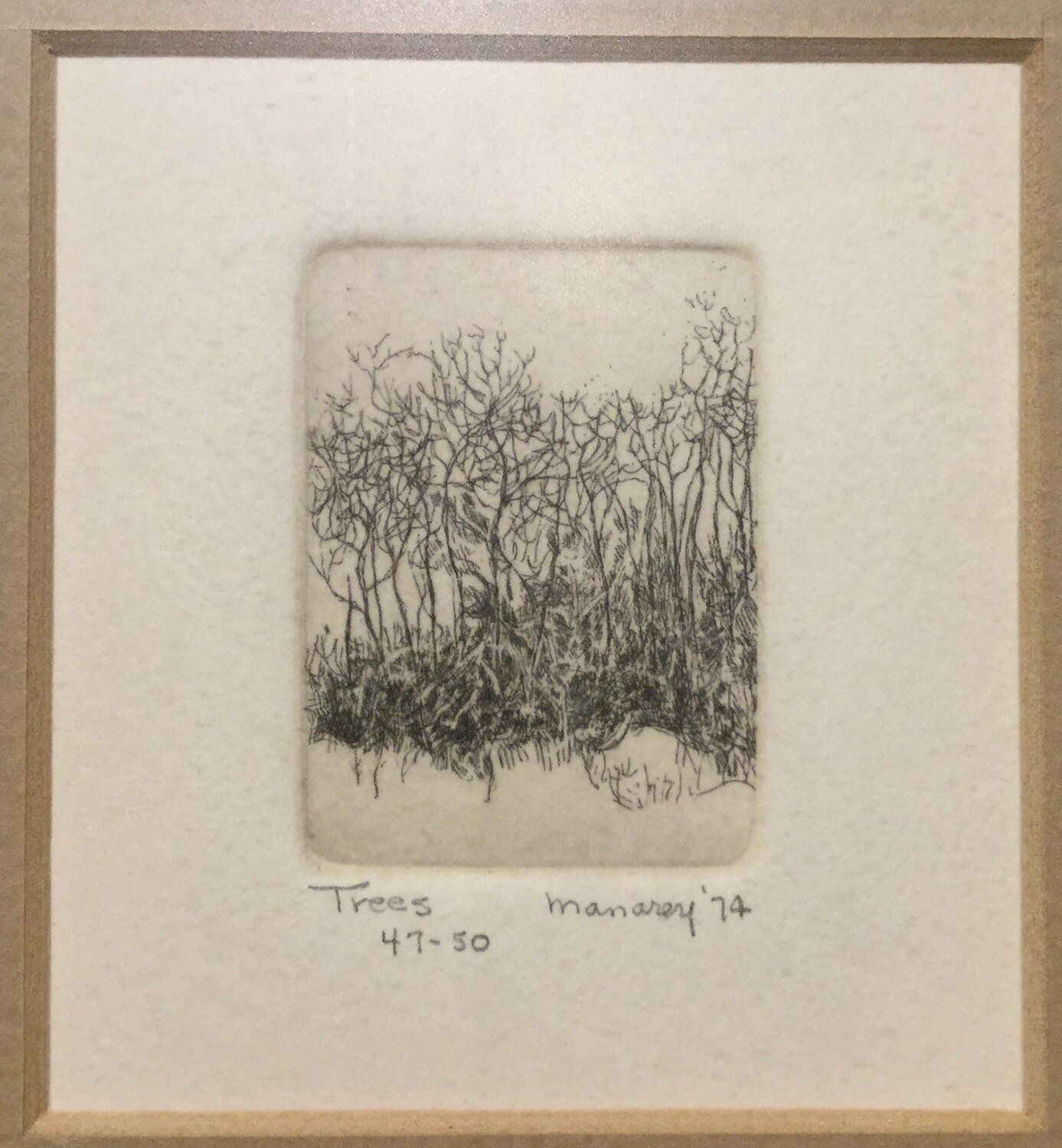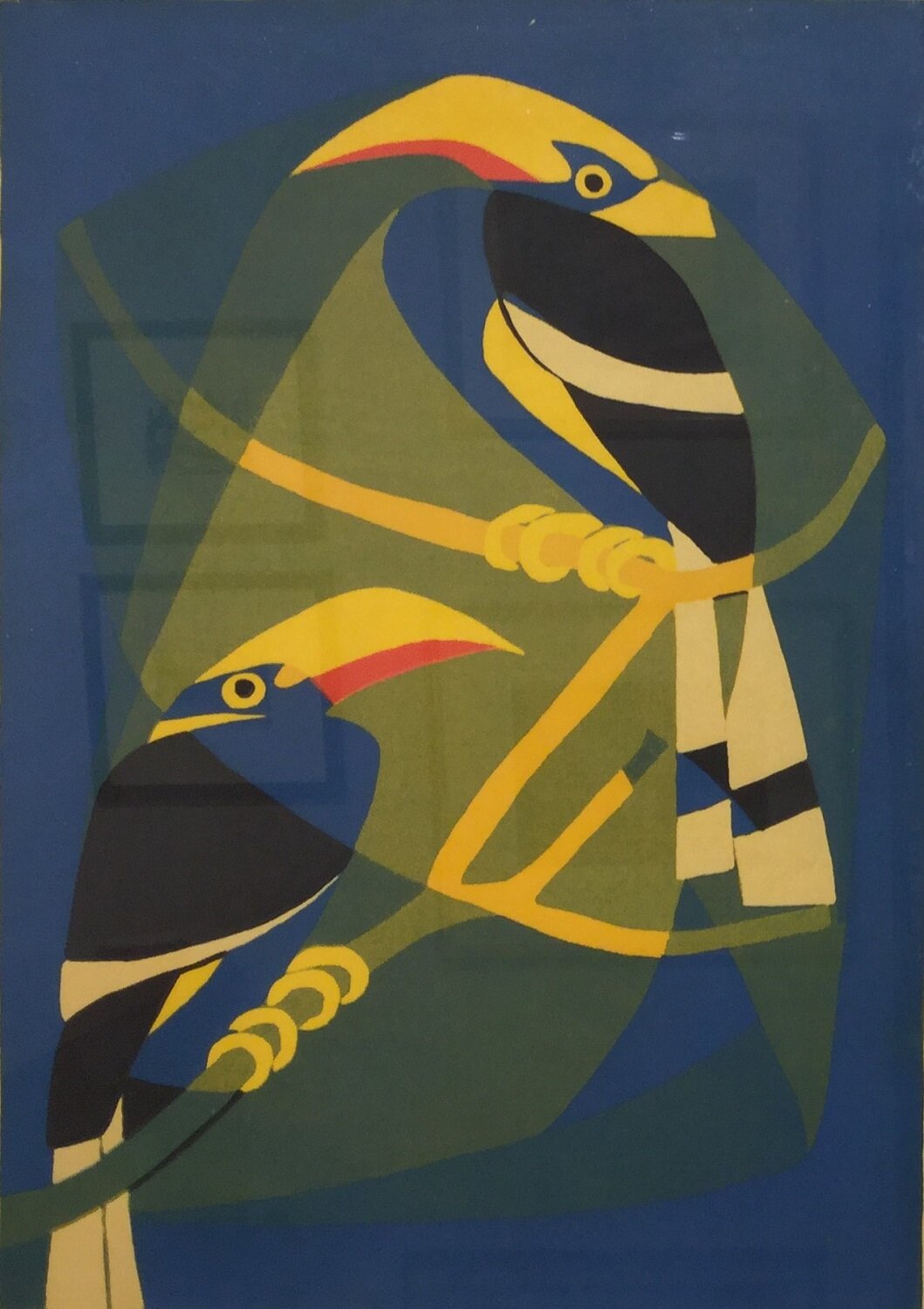Thelma Manarey ASA, CPE (1913-84)

South Of The House On The Farm, 1974, ed. 42/75, etching on paper, 1.75 x 2 inches (4.5 x 5 cm), original framing, provenance: Edmonton Collection, sold.

Spring Break-Up, 1974, ed. 56/75, etching on paper, 1.75 x 2 inches (4.5 x 5 cm), original framing, provenance: Edmonton Collection, sold.

Windbreak South Of Red Deer, 1969, a/p 3rd state, etching on paper, 2.75 x 3.75 inches, original framing, sold.

Girl, a/p 3rd state, etching on paper, 1 7/8 x 1 7/8 inches, original framing, sold.

Trees, 1974, ed.50, etching on paper, 2 x 1.75 inches, original framing, sold.

Triptych of Spring Thaw 1970, Trees 1972, Still 105 Street, 1972, etchings on paper, original framing, sold.

Thelma Manarey ASA, CPE (1913-84), Bush Trail, 1982, watercolor/paper, 13.5 x 21 inches, sold.

Thelma Manarey ASA, CPE (1913-84), Mountain Sketch, 1966, acrylic/panel, 9 x 10 inches, original frame, sold.

The Gingham Dog & The Calico Cat, 1956, pen & ink on paper, 5.25 x 4 inches (13.5 x 10 cm), framed, sold.

Barn, 1976, graphite drawing/paper, 10 x 14 inches, sold

Indian Horn Bills, 1957, ed.25, silkscreen on paper, 13.75 x 9.75 inches, original framing, sold.
“I enjoy nature so…”
Reference:
Ainslie, Patricia and Mary-Beth Laviolette, Alberta Art and Artists. Calgary: Fifth House, 2007.
Cochran, Bente Roed, Printmaking in Alberta 1945-1985. Edmonton: University of Alberta Press, 1989.
Greer, Joan, The Changing Picture, 65 Years of the Edmonton Art Club. Edmonton: Edmonton Art Club, 1987.
I enjoy nature so, and there are things in the Alberta landscape that are worth depicting: trees, space, and the vast panoramic landscape. When there are no leaves on the trees, you get ‘the etching forms’ silhouetted against the sky and the ground, especially when the snow covers the fields. But the spiritual quality is the hardest thing to get.
Born in Edmonton, Thelma Manarey studied with Florence Mortimer before moving to Calgary to attend art school (1939-43), where she studied under H.G. Glyde RCA at the Institute of Technology and Art (now the Alberta College of Art & Design). She was also part of a group of artists who worked with George Weber to learn the art of the serigraph. In the 1950s and 60s, she took part in numerous art workshops, including etching techniques with Harry Savage, UofC workshops with Shane Weare and Andre Stasik and in Toronto she learned stone lithography at the CPE print facilities (600 Markham Street). Between 1960 and 1963 Thelma attended summer extension courses at the Banff Centre School of Fine Arts, University of Washington, University of Alberta, as well as Emma Lake, Saskatchewan. In Saskatchewan she studied with John Ferren and Kenneth Noland.
Thelma Manarey became a member of the Edmonton Art Club in 1950, the oldest continuing art organization in Alberta. She was a member of the Alberta Society of Artists (ASA) and from 1956 taught art classes at the Edmonton Art Gallery as well as the Department of Extension, University of Alberta, which offered her opportunity to teach in the rural areas, including in the Northwest Territories.
Through her teaching Thelma gained access to rural spaces resulting in the depiction of the quiet details of such places: groves of trees, the rhythm of undulating hills, the meanderings of a fence line. Although she did work with the figure and in the abstract using oils and acrylics, she is best known for her miniature etchings and other printmaking that she began to create in the late 1960s. Her primary concern regardless of subject was the technical depiction of negative and positive space, a dichotomy which she successfully united with her emphasis on line.
As to medium and technique, I've run the gamut all right; realism, impressionism, cubism, abstract expressionism - the lot. Each of these explorations took a large chunk out of my life and while I was doing it I figured "this is the greatest". Now, with the etchings, I feel I've come full circle from 1955.
She was an active member of the Alberta Society of Artists and held several offices, including Vice-President (1967-68), 'Highlights' Editor (1957) and Assistant Editor (1960, 1963). She lectured at the EAG from 1953, was on the council of the EAG 1967-69. For her contributions to the Society, she was awarded the designation of Life Member. She was very involved in the arts in Edmonton. Thelma was presented with an A.Y. Jackson painting in 1962 for obtaining 68 new members for the Edmonton Art Gallery. In 1973, she received the Performing and Creative Arts Award, Visual Arts, from the city for her "outstanding contributions to the cultural life of Edmonton". She was also a member of the Canadian Society of Painters - Etchers and Engravers (CPE) and the Print & Drawing Council of Canada (PDCC).
Selected Collections: Thelma Manarey's work was chosen for many government buildings in Canada and abroad; she was commissioned to paint several official government portraits. Her work is represented in numerous public, corporate and private collections, including Alberta House (London, England) and the Edmonton Public School Board.
